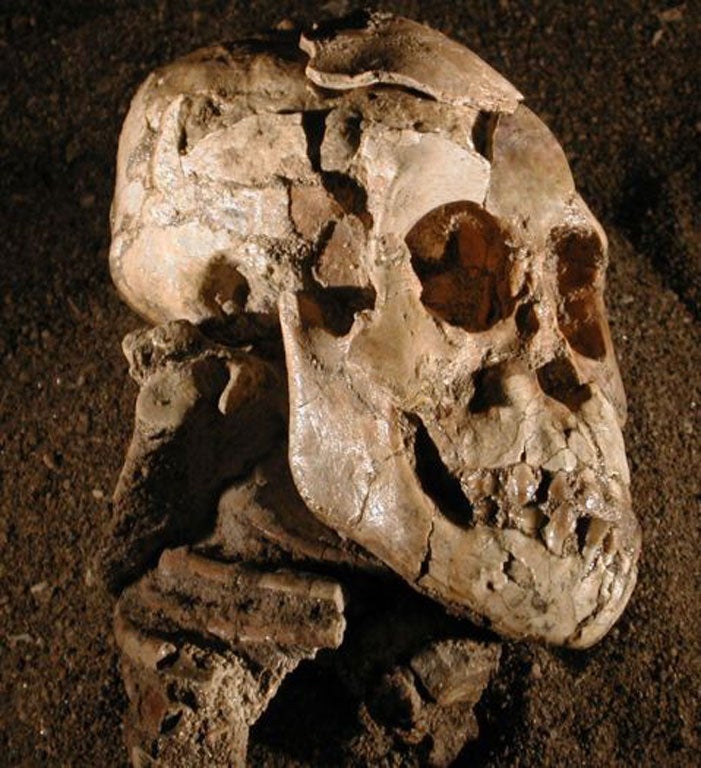The tree-climbing girl who turns the history of man on its head

Your support helps us to tell the story
From reproductive rights to climate change to Big Tech, The Independent is on the ground when the story is developing. Whether it's investigating the financials of Elon Musk's pro-Trump PAC or producing our latest documentary, 'The A Word', which shines a light on the American women fighting for reproductive rights, we know how important it is to parse out the facts from the messaging.
At such a critical moment in US history, we need reporters on the ground. Your donation allows us to keep sending journalists to speak to both sides of the story.
The Independent is trusted by Americans across the entire political spectrum. And unlike many other quality news outlets, we choose not to lock Americans out of our reporting and analysis with paywalls. We believe quality journalism should be available to everyone, paid for by those who can afford it.
Your support makes all the difference.The fragile remains of a three-year-old girl who died about 3.3 million years ago in East Africa have revealed that our early human ancestors still spent much of their time in the trees long after they had fully mastered the art of walking on two legs.
The discovery appears to have finally ended the debate over whether this bipedal hominid still continued to climb trees, much like their earlier ape ancestors.
The fossilised shoulder blades and arm sockets belonging to Selam, meaning "peace", indicate that she and her family continued to climb trees like modern apes even though her lower body was perfectly adapted to upright walking.
Scientists believe that the upward angle of her arm sockets and ape-like shoulder blades suggest that she was an active tree climber. This means that humanity's earliest ancestors abandoned an arboreal existence far later in our evolutionary history than previously thought.
Selam is a remarkably well-preserved specimen of the species Australopithecus afarensis, an important forerunner of the human lineage. Her almost-complete skull and skeleton, embedded in sandstone rock, was discovered in 2000 in the Dikika region of northeast Ethiopia and it has taken years of painstaking work for scientists to extract the fossilised bones from the stone.
The latest study, published in the journal Science, reveals the first complete set of shoulder blades of Australopithecus afarensis.
"The question as to whether Australopithecus afarensis was strictly bipedal or if they also climbed trees has been intensely debated for more than 30 years," said Professor David Green, curator in anthropology at the California Academy of Sciences and one of the authors of the study.
"These remarkable fossils provide strong evidence that these individuals were still climbing at this stage in human evolution," Professor Green said.
Trees were probably still an important refuge from the many large predators that roamed the land at the time. Trees were especially important for females nursing infants, especially at night.
Humans and apes shared their last common ancestor about 6.5 million years ago. The discovery in the same region of Ethiopia in 1974 of the first Australopithecus skeleton, a female called Lucy, showed that upright walking on two legs had evolved more than 3 million years ago, long before the emergence of the human genus "Homo" about a million years later.
Zeresenay Alemseged of the California Academy of Scientists, the scientist who first discovered Selam, has spent the past 11 years trying to extricate the bones, especially her fragile shoulder blades, from their sandstone tomb.
"Because shoulder blades are paper thin they rarely fossilise, and when they do they are almost always fragmentary. So finding both shoulder blades completely intact and attached to a skeleton of a known and pivotal species was like hitting the jackpot," Dr Alemseged said.
"This study moves us a step closer toward answering the question 'when did our ancestors abandon climbing behaviour?' It appears that this happened much later than many researchers have previously suggested," he said.
Descending from the trees and learning to walk upright on two legs is considered one of the defining moments in human evolutionary history that set our distant ancestors on the path towards sophisticated took making, the control of fire and complex social behaviour.
"This new find confirms the pivotal place that Lucy and Selam's species occupies in human evolution. While [they were] bipedal like humans, A. afarensis was still a capable climber. Though not fully human. A. afarensis was clearly on its way," Dr Alemseged said.
Although chimps and modern humans shared their last common ancestor about 6.5m years ago, it was only just over 2m years ago that the first humans emerged in the form of Homo habilis, or "handy man", a tool-making species with half the brain size of modern man.
Join our commenting forum
Join thought-provoking conversations, follow other Independent readers and see their replies
Comments